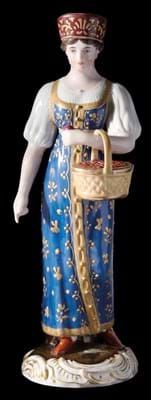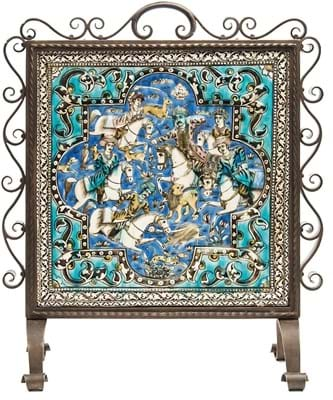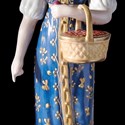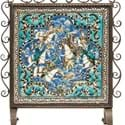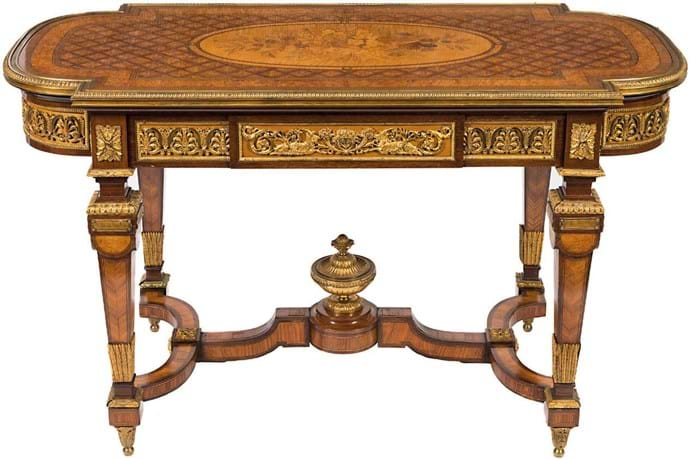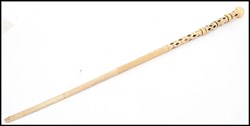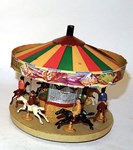Among the 900 lots, of which 80% got away to a hammer total of £490,000, some solid prices for English furniture and a decent Devon longcase emerged. However, these sales are generally a window on the wider world and the top bids came for continental silver, Russian, Persian and German ceramics and Chinese silks.
“With sterling low against the euro, we had a lot of continental interest but UK buying was also strong,” said auctioneer Nic Saintey.
Remarkable man
Three lots of Francis Gardner figures performed well.
Gardner was quite a remarkable man. A banker by profession, he learned the secrets of porcelain manufacture, sourced his high-grade kaolin and quartz on this travels round the Russian Empire and, in 1776, was allowed to open his factory at Verbilki about 50 miles north of Moscow.
From that village he was soon rivalling the St Petersburg Imperial Porcelain Factory itself – creating four huge services for Catherine the Great.
The offerings at BHL were the trademark early to mid-19th century porcelain figures from Russian life.
“I learned of the pieces about a year ago when a professional restorer asked me if they were worth working on,” said Saintey.
“I was surprised to see them being offered for sale so soon afterwards. I explained that the market was not what it was and that although the restoration had been very well done, it could count against high prices.”
The vendor “swallowed hard” and accepted estimates in the £300-700 range, added Saintey, who then saw them do considerably better.
Top of the troika of lots was a berry picker in a blue and gilt floral dress and a coachman wearing tall cerise hat, brown coat and bright sash.
Each 8in (20.5cm) tall, on rustic circular gilt scrolling bases with impressed factory marks and dated c.1830-40, they sold online to a UK-based enthusiast at £5500.
An 8in (20cm) tall male peasant dancer and his 6¼in (16cm) female partner, dating from the mid 19th century, more than tripled the estimate at £3000.
From slightly earlier was a desk stand in the form of a peasant kneeling by a hollow stump, with a bundle of logs on his back which contained an inkwell and pounce pot.
Lacking its cover, the 5in (13cm) high stand went at a nine-times estimate £3600 to the collector who took the dancing pair.
Hunted down
Persia’s contribution to the better-selling ceramics was a late 19th century Qajar moulded pottery panel depicting a hunting scene.
In a wrought-iron fire screen frame, the 17in (44cm) square panel suffered some damage including a long crack, but against a £300-500 estimate it sold to the London trade at £2900.
The reaction to a late 17th century Westerwald salt-glazed stoneware jug was more expected. It had been entered along with a German agate cup and the vendor was happy with a here-to-sell £500-700 estimate.
Of typical bulbous form, the 8in (20cm) tall jug was incised with scrolling flowers and foliage around a crowned ‘WR’ medallion and went to an American bidder at £2600.

German, probably 17th century silver-mounted agate cup and cover – £5500 at Bearnes Hampton & Littlewood.
The vendor’s other German piece provided the Exeter sale’s best-selling lot among the silver: a silver-gilt mounted moss agate cup and on knopped stem and circular foot.
Catalogued as probably late 17th century, the 4¼in (11cm) high cup had a crack to the cover, but hopes were higher than the £200- 400 estimate. The cup sold to the Paris trade at £5500.
The other silver success was a pair of 7½in (19cm) tall continental candlesticks formed as tied square cluster columns with square sconces, drip trays and stepped bases. Bearing French import marks and weighing 22oz, the pair took a 10-times estimate £3000, selling to a London dealer.
Napoleonic victory
Best of the furniture was another continental piece – a Napoleon III, Louis XVI-style mahogany, kingwood, burr walnut and marquetry table de milieu.
Featuring a central marquetry panel of floral, fruit and foliage to the 4ft 2in (1.26m) wide top and a frieze drawer applied with mounts in the Adam Weisweiler style, the table sold on the lower £7000 estimate to a local private buyer with a penchant for such material.
Also going on lower estimate at £6000 was a pair of mid 19th century kingwood, crossbanded pier cabinets with applied scagliola panels and gilt-metal mounts.
Standing 3ft 9in high by 2ft 7in wide (1.14m x 79cm), each was profusely decorated with chevron-veneered tops, acanthus scroll friezes and lions’ masks to the cut corners, and the quarter-veneered doors featured central oval panels of flowers surrounded by four oval-angled smaller panels.
Going at more than twice the top estimate was a Victorian mahogany and ebonised low bookcase stamped Holland & Sons. The 3ft 10in (1.17m) high x 5ft 4in (1.64m) long bookcase was surmounted by a panel of green marble and fitted with shelves enclosed by three glazed doors between moulded pilasters.
It sold at £3300 to the UK trade.
Devon representative
The Devon representative among the top-sellers was a 6ft 5in (1.95m) tall Victorian walnut floor-standing regulator signed to the circular silvered dial for the retailers Bennett, Torquay.
The movement, with dead-beat escapement, maintaining power and a mercury-filled jar to the compensating pendulum, was unsigned but two identical movements are known and signed Oder Birmingham.
Far from being a target of local pride, the clock sold to a collector from north-east England at a mid-estimate £5400.



